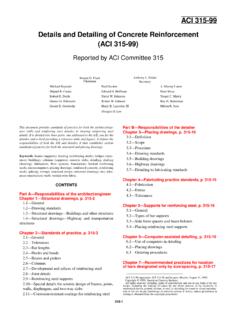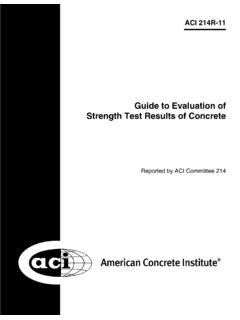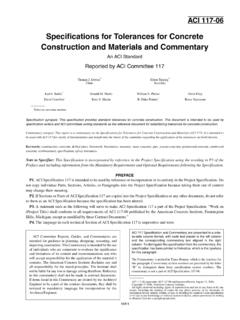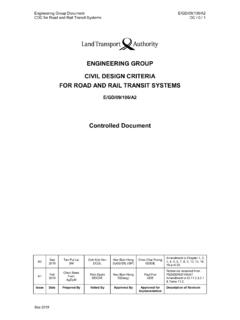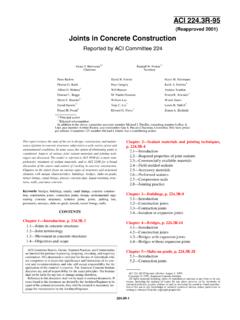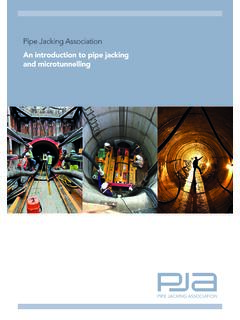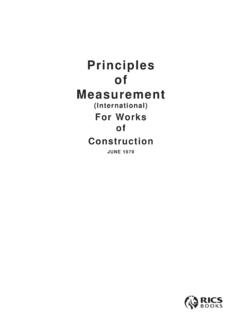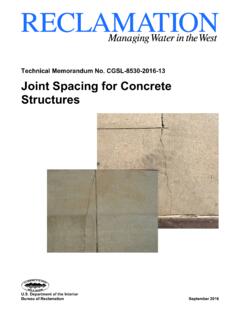Transcription of 207.1R-05 Guide to Mass Concrete
1 ACI supersedes ACI and became effective December 1, 2006, American Concrete rights reserved including rights of reproduction and use in any form or by anymeans, including the making of copies by any photo process, or by electronic ormechanical device, printed, written, or oral, or recording for sound or visual reproductionor for use in any knowledge or retrieval system or device, unless permission in writingis obtained from the copyright Committee Reports, Guides, and Commentaries areintended for guidance in planning, designing, executing, andinspecting construction. This document is intended for the useof individuals who are competent to evaluate the significanceand limitations of its content and recommendations and whowill accept responsibility for the application of the material itcontains.
2 The American Concrete Institute disclaims any andall responsibility for the stated principles. The Institute shallnot be liable for any loss or damage arising to this document shall not be made in contractdocuments. If items found in this document are desired by theArchitect/Engineer to be a part of the contract documents, theyshall be restated in mandatory language for incorporation bythe Architect/Engineer. to Mass ConcreteReported by ACI Committee 207 ACI Concrete is any volume of Concrete with dimensions large enough torequire that measures be taken to cope with the generation of heat fromhydration of the cement and attendant volume change to minimize design of mass Concrete structures is generally based on durability,economy, and thermal action, with strength often being a secondary document contains a history of the development of mass concretepractice and discussion of materials and Concrete mixture proportioning,properties, construction methods, and equipment.
3 It covers traditionally placedand consolidated mass Concrete and does not cover roller-compacted : admixture; aggregate; air entrainment; batch; cement; compressivestrength; cracking; creep; curing; durability; fly ash; formwork; grading;heat of hydration; mass Concrete ; mixing; mixture proportion; modulusof elasticity; placing; Poisson s ratio; pozzolan; shrinkage; strain; stress;temperature rise; thermal expansion; vibration; volume 1 Introduction and historical developments, p. Temperature Long-term strength designChapter 2 Materials and mixture proportioning, p. Pozzolans and ground Chemical Selection of Temperature controlChapter 3 Properties, p. Elastic Volume Thermal Shear DurabilityChapter 4 Construction, p.
4 Height of lifts and time intervals between Cooling and temperature Grouting contraction jointsJeffrey C. AllenRobert W. CannonJohn R. HessTibor J. PatakyTerrence E. ArnoldTeck L. ChuaRodney E. HolderbaumSteven A. RaganRandall P. BassEric J. DitcheyAllen J. HulshizerErnest K. SchraderJ. Floyd BestTimothy P. DolenDavid E. KieferGary P. WilsonAnthony A. BombichBarry D. FehlGary R. MassStephen B. COMMITTEE REPORTC hapter 5 References, p. Referenced standards and Cited referencesCHAPTER 1 INTRODUCTIONAND HISTORICAL ScopeMass Concrete is defined in ACI 116R as any volume ofconcrete with dimensions large enough to require thatmeasures be taken to cope with generation of heat fromhydration of the cement and attendant volume change tominimize cracking.
5 The design of mass Concrete structuresis generally based on durability, economy, and thermalaction, with strength often being a secondary, rather than aprimary, concern. The one characteristic that distinguishesmass Concrete from other Concrete work is thermal the cement-water reaction is exothermic by nature,the temperature rise within a large Concrete mass, where theheat is not quickly dissipated, can be quite high. Significanttensile stresses and strains may result from the restrainedvolume change associated with a decline in temperature asheat of hydration is dissipated. Measures should be takenwhere cracking due to thermal behavior may cause a loss ofstructural integrity and monolithic action, excessive seepageand shortening of the service life of the structure, or beaesthetically objectionable.
6 Many of the principles in massconcrete practice can also be applied to general concretework, whereby economic and other benefits may be document contains a history of the development ofmass Concrete practice and a discussion of materials andconcrete mixture proportioning, properties, constructionmethods, and equipment. This document covers traditionallyplaced and consolidated mass Concrete , and does not coverroller-compacted Concrete . Roller-compacted Concrete isdescribed in detail in ACI concreting practices were developed largely fromconcrete dam construction, where temperature-relatedcracking was first identified. Temperature-related crackinghas also been experienced in other thick-section concretestructures, including mat foundations, pile caps, bridge piers,thick walls, and tunnel compressive strengths are usually not required in massconcrete structures.
7 However, thin arch dams are structures, such as gravity dams, resist loads primarilyby their shape and mass, and only secondarily by their more importance are durability and properties connectedwith temperature behavior and the tendency for effects of heat generation, restraint, and volumechanges on the design and behavior of massive reinforcedelements and structures are discussed in ACI and insulating systems for mass Concrete areaddressed in ACI Mixture proportioning for massconcrete is discussed in ACI HistoryWhen Concrete was first used in dams, the dams wererelatively small and the Concrete was mixed by hand. Theportland cement usually had to be aged to comply with aboiling soundness test, the aggregate was bank-run sand andgravel, and proportioning was by the shovelful (Davis 1963).
8 Tremendous progress has been made since the early 1900s,and the art and science of dam building practiced today hasreached a highly advanced state. Presently, the selection andproportioning of Concrete materials to produce suitablestrength, durability, and impermeability of the finishedproduct can now be predicted and controlled with herein are the principal steps from those verysmall beginnings to the present. In large dam construction,there is now exact and automatic proportioning and mixingof materials. Concrete in 12 yd3 (9 m3) buckets can be placedby conventional methods at the rate of 10,000 yd3/day(7650 m3/day) at a temperature of less than 50 F (10 C) asplaced, even during extremely hot weather. Grand CouleeDam still holds the all-time record monthly placing rate of536,250 yd3 (410,020 m3), followed by the more recentachievement at Itaipu Dam on the Brazil-Paraguay border of440,550 yd3 (336,840 m3) (Itaipu Binacional 1981).
9 Therecord monthly placing rate of 328,500 yd3 (250,200 m3) forroller-compacted Concrete was achieved at Tarbela Dam inPakistan. Lean mixtures are now made workable by meansof air entrainment and other chemical admixtures and the useof finely divided pozzolanic materials. Water-reducing,strength-enhancing, and set-controlling chemical admixturesare effective in reducing the required cement content to aminimum and in controlling the time of setting. Placing ratesfor no-slump Concrete , by using large earth-moving equipment fortransportation and large vibrating rollers for consolidation,appear to be limited only by the size of the project and itsplant s ability to produce Before 1900 Before to the beginning of the twentiethcentury, much of the portland cement used in the UnitedStates was imported from Europe.
10 All cements were verycoarse by present standards, and quite commonly they wereunderburned and had a high free lime content. For dams ofthat period, bank-run sand and gravel were used without thebenefit of washing to remove objectionable dirt and mixtures varied widely in cement content and insand-coarse aggregate ratio. Mixing was usually done byhand and proportioning by shovel, wheelbarrow, box, or effect of the water-cement ratio (w/c) was unknown, andgenerally no attempt was made to control the volume ofmixing water. There was no measure of consistency except byvisual observation of the newly mixed of the dams were of cyclopean masonry in which plums (large stones) were partially embedded in a verywet Concrete .
![6ITSVXIH F] %'- 'SQQMXXII - dl.mycivil.ir](/cache/preview/4/b/b/f/2/e/8/1/thumb-4bbf2e81b2b2df04c22714e49f0954ce.jpg)

